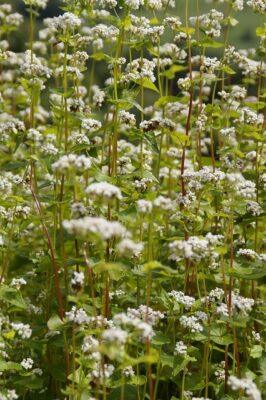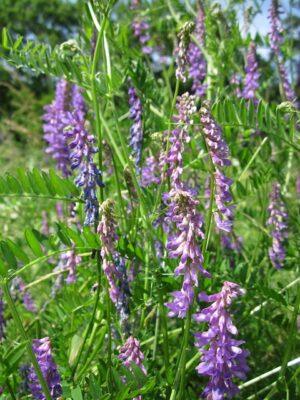
There’s no reason why your garden should remain unproductive between fall harvest and spring planting. Planting a cover crop, which isn’t just for big agricultural operations, ensures your garden keeps working hard throughout the offseason.
Plant a cover crop after harvest, about four weeks before the first hard frost, and then till it into the ground in late winter or early spring. The organic matter builds healthier soil, helps smother weeds, loosens compacted soil, helps control diseases, attracts beneficial insects, keeps pests in check and prevents erosion – all for a very reasonable investment of time and money.
Loosen the top 1 to 2 inches of soil, then sow the seeds thickly, much like grass seeds. Rake the seeds into the soil, then tamp lightly so the seeds make good contact with the soil.
Keep in mind that many cover crops can become weedy if they are allowed to set seeds, so plow them under before that occurs, preferably while the plants are still young and easy to work. Don’t worry if it seems that your crop hasn’t been around long enough to be helpful; growing cover crops for a short time provides great benefits.
Looking For Non-GMO Seeds? Get Them From A Company You Can Trust!
Here are a few examples of fast-growing cover crops that work well for small gardens in nearly any climate:

1. Buckwheat is great for poor or unproductive soil, or where weeds are a persistent problem. Plant buckwheat any time between late spring and late summer, and then wait five or six weeks before tilling it into the soil. Unfortunately, buckwheat prefers cool, moist conditions and isn’t the best choice for hot, dry climates. Don’t let this plant go to seed, which usually occurs in six to nine weeks.
2. Clover is a terrific source of nitrogen. Many gardeners prefer crimson clover, a robust plant with colorful blooms. However, other types, including yellow blossom clover, sweet clover, white Dutch clover, arrowleaf clover, berseem clover and others all attract beneficial nutrients, fix nitrogen, suppress weeds and attract bees and other beneficial insects. Do your homework and select the clover that works best in your climate.
3. Oilpan radishes have long, fast-growing taproots that power through compacted soil in a couple of months. Plant the radishes in late summer or early fall and the plants will continue to work throughout the winter months, even if they are killed by a hard freeze. Be careful and don’t let the radishes go to seed, as volunteer plants may create big problems in next year’s garden.
4. Winter rye is a good cover crop for dry, sandy, poor soil, and it works well in cold climates. The seeds are quick to germinate and suitable for planting late in the season. One drawback however, is that winter rye grass doesn’t provide a full slate of nutrients, so you may want to combine winter rye with clover, vetch, or other plants from the legume family.
Seamazing: The Low-Cost Way To Re-mineralize Your Soil

5. Hairy vetch is a versatile, resilient legume that works well even in cold, dry climates and nearly any soil type. Plant hairy vetch in late summer or early autumn and work it into the soil in spring. Alternatively, trim or mow the vetch before it blooms — a few weeks before garden planting time, and then plant your vegetable seeds directly in the mulch. Don’t let hairy vetch bloom, as it can become very weedy.
6. Fava beans are hardy, relatively drought-tolerant legumes that germinate quickly and tolerate most soil types. However, this cool-season crop doesn’t do as well when temperatures exceed 80 degrees Fahrenheit, so wait until temperatures drop a bit before planting. As an added bonus, fava beans are edible, although removing the pods also reduces the nitrogen available to the soil.
7. Garden peas are a dual-purpose plant that provides all the benefits of legumes. For best results, till garden peas into the soil while they’re flowering. You also can combine garden peas with other cover crops such as winter rye or vetch.
8. Oats don’t provide the rich buffet of nutrients as do other plants, but they are good choices for wet soil. The plants are winterkilled in most climates, but the frozen plant matter provides many benefits, including erosion control and loosening of compacted soil.
What cover crops would you recommend? Share your tips in the section below:
Every Year, Gardeners Make This Stupid Mistake — But You Don’t Have To. Read More Here.










